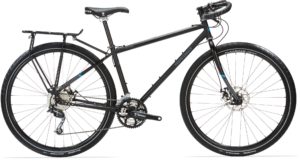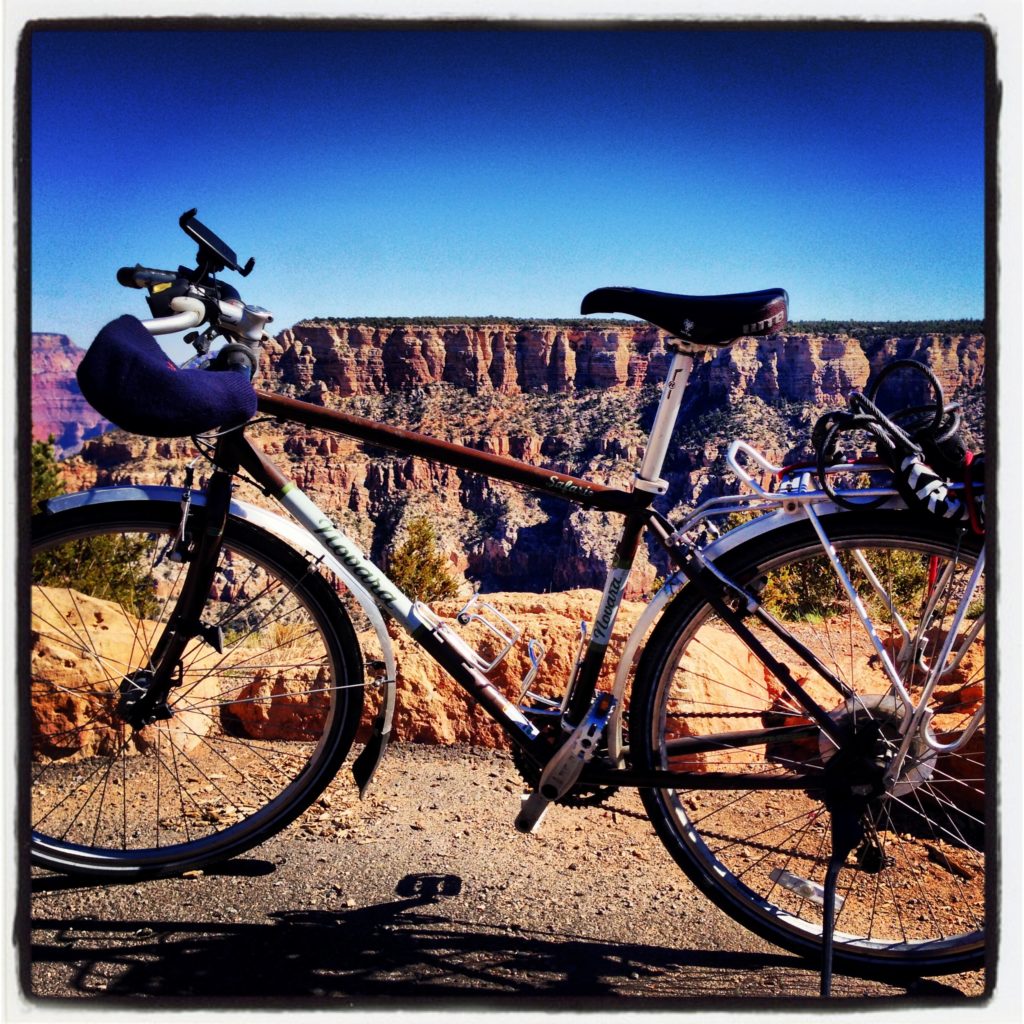It’s hard to argue that the most important piece of gear you bring with you on tour is your bicycle. Sure we talk a lot about tents, cooking gear, toolkits, panniers and other things that make life easier on the road, but it’s the bike that gets us there. When I was looking to upgrade from my heavily modified (non-touring) bike[footnote]for the record, a Marin mountain bike… with front suspension. Not recommended once you decide to make the leap, by the way.[/footnote] to something more built for the road, I spent weeks analyzing, hand-wringing and studying feature lists. The next few posts will feature my three favorite touring bikes.[footnote]Be sure also to check out reviews of the Surly Long Haul Trucker, hacking your own ride, and the Dahon Vitesse[/footnote] This time, it’s my pride and joy Sequoia sempervirens… the Novara Safari.
Quick sidebar/updates

The news from 2016 Interbike was a gut punch for fans of the Safari… with the end of the Novara line of bicycles, the Safari did not survive the purge as-is. REI’s new line of bikes, called Co-Op (see what they did there?) did include touring bikes, and the great news is the new ADV 2.1 is pretty much an evolution of my beloved Safari. I’ll be doing a complete revamp of the reviews here since the ADV 2.1 is by all accounts the natural successor. Here’s a video from REI with the details:
Prior to the rebrand, the Safari was last redesigned in 2016. The stock model now comes standard with disc brakes and thumb shifters as opposed to the rim brakes and grip shifters of the one I ride. The tires are also now Vittoria rather than Continental. It seems like the new Safari is being targeted to touring that includes trails and gravel in addition to road work, which I think is a great space for it to reside amongst the REI bikes since the Novara Randonee occupies the classic drop-bar road touring slot. I’ll update the review when I get an opportunity to ride the new version. Onto the review of the 2014 model, which you may be finding more of on the secondary markets…
Great specs + bang for the buck
The Safari has a great set of specs, comes in a little cheaper than some of the other top bikes out there, and has the added bonus of being from REI if you are a member (that dividend covers some pretty sweet gear when it rolls in). 
Favorite features
The first thing you notice with the Safari is the stock moustache handlebars. They’re distinctive, and maybe a little controversial. I strongly prefer them over traditional drop bars because of the variety of hand positions you can achieve with subtle shifts while riding. When I’m riding other bikes for more than a few miles, I tend to miss my moustache bars. They’re great for touring.
Another nice feature for the Safari is the very nice rear rack that comes standard. Is it a little heavier than other options out there? Sure. But it’s very sturdy and can handle a rough tour with few complaints.
Like many good touring bikes, the Safari has a steel frame, which makes it ideal for the rigors of travel. The components are solid, and with a few exceptions I’ll get to in a moment, I’ve ridden most of my tours on the stock parts.
While tour-ready once you roll it out of the store, he Safari is also highly customizable. There are brazons all over the frame for fenders, water bottles, pumps, and more. I even attached a rear rack modified as a front rack using some old water bottle cages and two hose clamps. It’s probably my favorite part of the bike.
A few downsides
While the components are excellent[footnote]three seasons of reasonably decent touring, approximately 3000 miles, and I am just now replacing the original shift cables[/footnote] I strongly recommend you break out the loktite before any tour and secure the threads on everything. It seems to be a problem for the Safari, and I definitely lost a few bolts in my first season.
The stock tires are Continentals. Decent tires. However… well, we all know what happened to mine. I moved up to a burlier tire.[footnote]The Schwalbe Marathon Supreme 28.0 x 2.0 tires fits the 700c wheels of the Safari. Highly recommended.[/footnote]
I promise I will not bore you to death by nerding out on gear ratios. There are way better sites for that. That said, the crankset that comes standard on the Safari is adequate, but not ideal for climbing hills. I found my ride down the Pacific Coast in 2014 to be substantially better when I swapped out the standard 48/36/26 triple for a 44/32/22 crankset. I love having that extra climbing ring, and the magic of physics kicks in with the smaller set. Bottom line: better climbing.
A minor quibble, and it’s more about personal preference: I don’t like to clip or strap in while touring. The Safari stock pedals have straps and I swapped those out after the first year. Like any strapped pedal, they flip over if you eschew their use and that can cause the foot holster to drag on the ground occasionally. I changed to an inexpensive platform pedal.
Bottom line
Ok, ok I’m biased. I love this bike. I ride this bike. Every once in a while I’ll see someone else riding one “in the wild” and I feel like a Mac user from the early 1990s who wants to connect with the other fan of a great, but lesser-used product.
Next time… the Surly Long Haul Trucker.
Want more?
There’s a whole series on my favorite touring bikes that I already mentioned, but you might also be interested in listening to The Pedalshift Project bike touring podcast. If you’re really into bike touring (new or not!) consider signing up for the free Pedalshift monthly newsletter for even more bike touring goodness.
